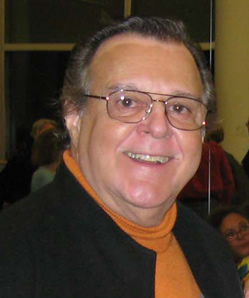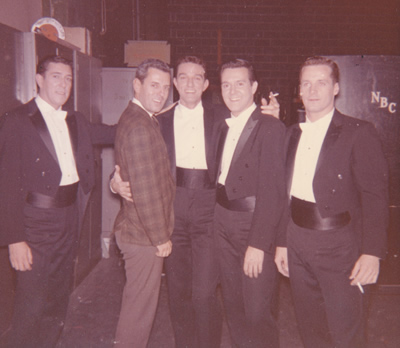Dancers Over 40 ARTS Legacy

TEAK LEWIS Interviewed by Lawrence Merritt What Inspired You To Become A Dancer? I started dancing as a teen at George Washington High School in upper Manhattan, and I was a member of the Pan-American Club and asked to do something for one of their shows, and I decided that I was going to do a dance, but I had no dance training. I just stole from what I had seen on the screen and used some of Jack Cole’s movements and poses with these girls who knew as much dancing as I did. As a result of that, I said, you know what? Let me go out and study dancing! Jack Cole being my first inspiration, I ended up going to the Kathryn Dunham School of Cultural Arts, where I studied West Indian dancing. Walter Nicks was my primary teacher there, even though Emile Faustin and Sevilla Fort also taught classes. Jack Cole really did something to me when I saw him do Kismet and I ended up going to La Meri on East 59th St. I was also able to audition for the High School for the Performing Arts then and because they were so hungry for male dancers I only had to do triplets across the floor and was accepted. The only problem was they wanted me to be a modern dancer and I wanted to move in a different direction. I ended up leaving high school in my senior year. I did not graduate there and went into the Air Force. I started doing dances and I was doing my East Indian fire dance, which I invented off the top of my head – fabulous costumes and very little choreography, bare chested with little pots of fire I used to light up and rotate. I became the premiere dancer of France. I competed in the European finals and I was beaten out by a tap dancer. It wasn’t until I got out of the service that I started taking dance much more seriously. At that time my name was Oscar Torres and I worked in Equity for about 4 years as Oscar and when I got into the national tour of Carnival, Jonathan Lucas was dong the role that James Mitchell had done on Broadway and he said to me one day that I didn’t look Latin enough to have a Latin name, so when the tour closed I became Teak Lewis. I got Teak from Morton DaCosta, whose nickname was Teak, and Lewis from Robert Lewis, a noted Broadway director. So Teak Lewis was born in the summer of 1963, and I had a career that ended in 1973. I stopped dancing because I was approaching 40 and dancing with kids who were 18 and 20. I thought it was time to move on. |
Is there any person who was most important in your career? I would have to say Jonathan Lucas, who was our Marco the Magnificent in the national tour of Carnival. He was extremely important to me. He hired me to do four Bell Telephone Hours and at that point I thought that I had arrived and I would be working forever on television. Unfortunately Jonathan got a job in California doing the Dean Martin Show and they were developing the all-girl Gold Diggers, so I was out of a job. He taught me that when you work with a star the object was to make her look good, not to do all these fancy steps that meant absolutely nothing. I got to work with Eleanor Powell. To me, she was the queen of tap. If ever I get depressed I watch her and Fred Astaire do Begin the Beguine, and that’s what dancing is all about. As far as developing myself as a dancer, it was George Reich who allowed me to become a prinicipal dancer, first by replacing the lead at the Latin Quarter when she was out and then when I did the show in Europe. I went as company manager, lead dancer, wardrobe person and mover of troops. What was the highlight of your career? I’ve always said that I had two highlights in my career. The first was to be picked by Gower Champion, whom I idolized, when they were getting the national company of Carnival together. I had just finished doing summer stock and I had been picked as one of the two boys to do the Steam Heat number in Pajama Game and in the following show we were doing Gentlemen Prefer Blondes and I got to do the Mamie is Mimi number. It was the first time I was out of the chorus and into a featured dancer spot. For Carnival, I took over the role that was done on Broadway by DO40 member George Marcy as one of the four roustabouts. I was in the company of Bob Avian and Roger Page. I was out of the chorus and now a featured dancer. Through Gower Champion I got to meet Jonathan Lucas, who choreographed the Eleanor Powell number and that I consider the second highlight in my career. I was one of the six boys, but I was dancing along side Eleanor Powell – THE Eleanor Powell. Later on I taught tap to children and they had no idea who she was when I brought up her name. I felt remiss that no one was teaching dance history, that no one knew the famous people who brought dance to the forefront. Is there anything you’d like to pass on from your wonderful history to someone coming up in our ranks? The first thing I would have to say is learn every style of dance you can. I remember being in Spain, out of work after our show closed in Europe, and a very famous Spanish singer, dancer asked me to choreograph a number for her. It was in the style of Flamenco but I was able to capture the air. She had the steps but I was able to put together a number for her because I had, at one point, studied a little of that. Don’t get into a niche and feel that you’re taking class with someone whose work you do easily. Go to a teacher whose work you really don’t understand. You have to test yourself all the time. Expand your horizons. Learn to sing. You have to be able to act, dance and be a triple threat if you really want to succeed in the business today. That we owe to Jerry Robbins, who hired dancers who could sing and act, to Gower Champion who hired dancers who could sing and act, and Michael Kidd who did the same thing. Do it all!
From the Bell Telephone Hour: L to R: | |


